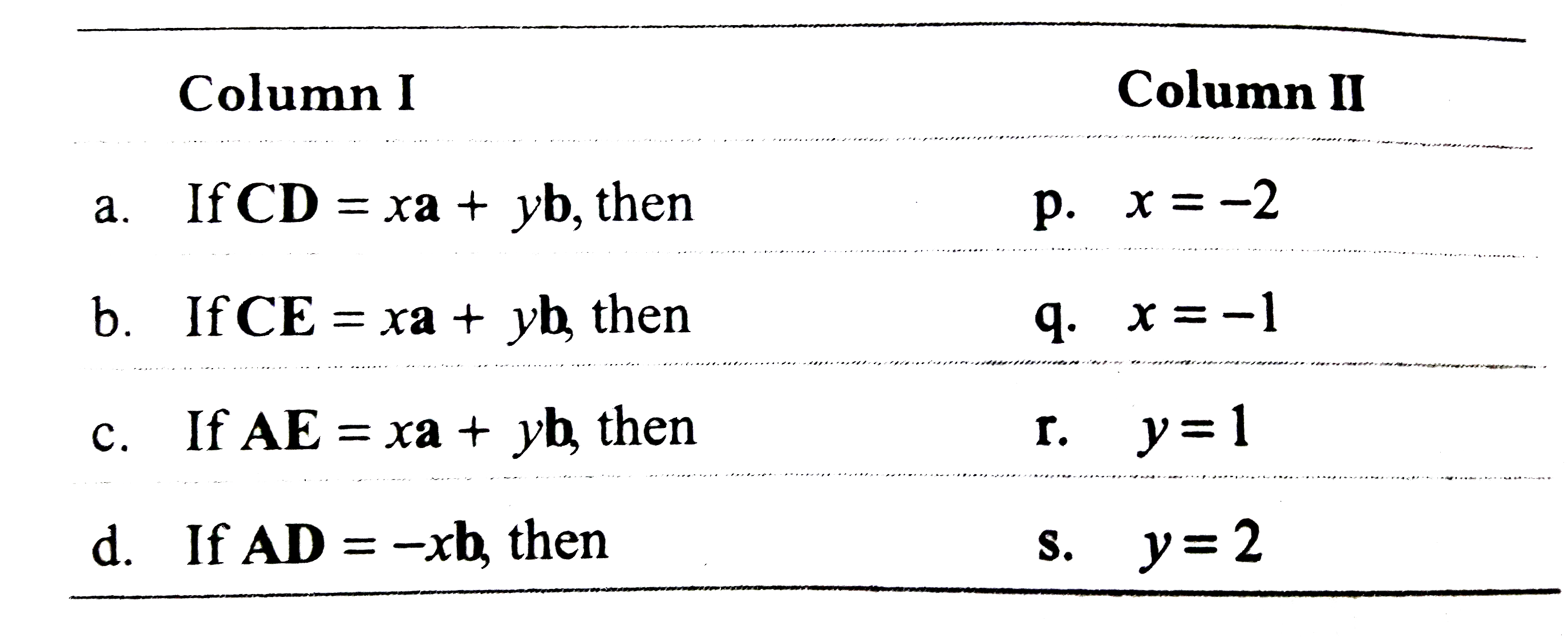a and b form the consecutive sides of a regular hexagon ABCDEF.

The correct Answer is:a→q,r;b→p,r;c→q,s;d→p

−−→AB=→a,−−→BC=→b ltvrgt ∴−−→AC=−−→AB+−−→BC=→a+→a (i)
−−→AD=2−−→BC=2→b (ii)
(because AD is parallel to BC and twice its length).
−−→CD=−−→AD−−−→AC=2→b−(→a+→b)
=→b−→a
−−→FA=−−−→CD=→a−→b (iii)
−−→DE=−−−→AB=−→a (iv)
−−→EF=−−−→BC=−→b (v)
−−→AE=−−→AD+−−→DE=2→b−→a (vi)
−−→CE=−−→CD+−−→DE=→b−→a−→a=→b−2→a (vii)
Topper's Solved these Questions
- INTRODUCTION TO VECTORS BOOK - CENGAGE ENGLISHCHAPTER - INTRODUCTION TO VECTORS EXERCISE - TRUE OR FALSE
1 Videos
- INTEGRALSBOOK - CENGAGE ENGLISHCHAPTER - INTEGRALSEXERCISE - All Questions
764 Videos
- INVERSE TRIGONOMETRIC FUNCTIONSBOOK - CENGAGE ENGLISHCHAPTER - INVERSE TRIGONOMETRIC FUNCTIONSEXERCISE - Archives (Numerical Value type)
2 Videos
Similar Questions
In a regular hexagon ABCDEF, −−→AE
View SolutionThe coordinates of two consecutive vertices A and B of a regular hexagon ABCDEF are (1,0) and (2,0) respectively. The equation of the diagonal CE is:
View SolutionAB, BC and CD are the three consecutive sides of a regular polygon. If ∠BAC=15∘, find,
number of sides of the polygon
View SolutionAB, BC and CD are the three consecutive sides of a regular polygon. If ∠BAC=15∘, find,
each exterior angle of the polygon
View SolutionIf →a, →b are the vectors forming consecutive sides of a regular of a regular hexagon ABCDEF, then the vecrtor representing side CD is
a.→a+→b b. →a−→b c. →b−→a d. −(→a+→b)
View SolutionIf →aand→b are the vectors determined by two adjacent sides of a regular hexagon ABCDEF, find the vector determined by the ther sides taken in order. Also find −−→ADand−−→CE in terms of →aand→b.
View SolutionConsider the regular hexagon ABCDEF with centre at O (origin).
Q. Five forces AB,AC,AD,AE,AF act at the vertex A of a regular hexagon ABCDEF. Then, their resultant is (a)3AO (b)2AO (c)4AO (d)6AO
View SolutionIf a and b are the vectors AB and BC determined by the adjacent sides of a regular hexagon. What are the vectors determined by the other sides taken is order?
View SolutionThree vertices are chosen at random from the vertices of a regular hexagon then
The probability that the triangle has exactly two sides common with the side of the hexagon is
View SolutionA particle moves with constant speed v along a regular hexagon ABCDEF in the same order. Then the magnitude of the avergae velocity for its motion form A to
View Solution
